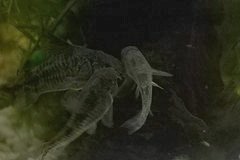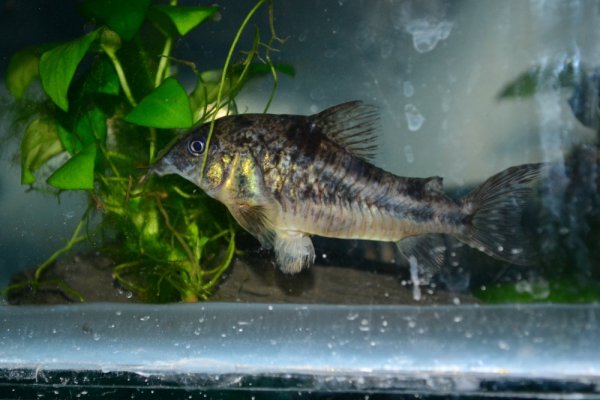J.Mcpeak
Aquarium Advice Addict
Submitted by Jamie McPeak.
Corydoras Paleatus
Synonyms: No known alternatives
Common Names: Peppered Cory.
Category: Species, Armoured Catfish
Family: Callichthyidae, subfamily Corydoradinae
Origin: South America: SE Brazil
Main Ecosystem: River, La Plata
Salinity: Freshwater
Temperament: Friendly, Peaceful, schooling.
Diet: Omnivore, plant safe. Catfish pellets (sinking), algae wafers, flake, carnivore pellets, bloodworm.
Care: Corydoras sp. are a social species, more is better 6+ 90cm/36in tank min. for C. Paleatus.
They need sand as a substrate this is essential, which must be clean. The barbels are prone to bacteria and will eventually wear down on large stones as they try to root through it. This fish is a scavenger and sand sifter with similar behaviour to goby species. They will adequately sift through sand preventing stagnation providing it is not too deep <15mm/0.6inch. Ideal for planted tanks. This species including all in its subfamily must be allowed to surface for air. Typical to the subfamily, dorsal fin carries a spine which can deliver a sting similar to a nettle or bee.
pH: 6-7
Temperature: 20-24'C 68-75'F
Hardness: 6-12'dH
Potential size: 7cm, males smaller.
Water Region: Demersal. Bottom, however species is not shy.
Activity: Diurnal (active during daylight)
Lifespan: 4-6 Years
Color: Light sand, dark brown patches and spots, green iridescence all over, sand to white underside.
Mouth: Subterminal, downward pointing with barbels
Sexing: Males smaller to 5cm, females much larger and bulkier through the pectoral region.
Acclimation: Hardy fish, allow temperature to acclimate.
Breeding:
Add a large amount of water @ 17 C' approx 62 F'
Works every time.
It replicates the rainy season in the amazon, let the ph down with the new water, rain is pure, pH 6 will be fine.
You can use this method every 6 weeks, allow females time to recover.
Move to a spawning tank first, after eggs have been laid return stock to main system. 20-50 fry per female is not unusual. Expect a few runts. Deal with these accordingly.
The fish will adopt the T position (see attachment, male to the right) after the females stop receiving milt the male can be removed, the female will clean any area before carefully placing the fertilised, adhesive eggs with her cupped ventral fins. No observed egg or brood care. Egg size approx <3mm/0.12in.
Allow plenty of tanks to break the fry out into.
3 off, 60x30x30cm 2x1x1Ft will be fine for most broods per female.
This works for most if not all corydoras sp.
You will need liquifry or similar food for egg layers.
The eggs will drop after 3-5 days. Start feed at this time, after two weeks you will see the fry, before this time look closely you will see small flecks like glass shooting up and down, allow for the fact these fish take oxygen gulps from the surface.
After about 15 days from initial deposit of eggs you can begin feeding larger food stuffs. Sinking catfish pellets ground in a pestle and mortar to fine dust will be ok. Once the fish reach 1inch 2.5cm treat as adult fish.
An open ended airline is sufficient filtration until adult stage.
Monitor water, for changes, syphon slowly from the uppermost portion of the fry tanks.
Sources: Baensch et al, Dr Carrington, A Excell, Dr Andrews, G Sandford,
J McPeak.
Note:The use of copyrighted material is protected by law.
Corydoras Paleatus
Synonyms: No known alternatives
Common Names: Peppered Cory.
Category: Species, Armoured Catfish
Family: Callichthyidae, subfamily Corydoradinae
Origin: South America: SE Brazil
Main Ecosystem: River, La Plata
Salinity: Freshwater
Temperament: Friendly, Peaceful, schooling.
Diet: Omnivore, plant safe. Catfish pellets (sinking), algae wafers, flake, carnivore pellets, bloodworm.
Care: Corydoras sp. are a social species, more is better 6+ 90cm/36in tank min. for C. Paleatus.
They need sand as a substrate this is essential, which must be clean. The barbels are prone to bacteria and will eventually wear down on large stones as they try to root through it. This fish is a scavenger and sand sifter with similar behaviour to goby species. They will adequately sift through sand preventing stagnation providing it is not too deep <15mm/0.6inch. Ideal for planted tanks. This species including all in its subfamily must be allowed to surface for air. Typical to the subfamily, dorsal fin carries a spine which can deliver a sting similar to a nettle or bee.
pH: 6-7
Temperature: 20-24'C 68-75'F
Hardness: 6-12'dH
Potential size: 7cm, males smaller.
Water Region: Demersal. Bottom, however species is not shy.
Activity: Diurnal (active during daylight)
Lifespan: 4-6 Years
Color: Light sand, dark brown patches and spots, green iridescence all over, sand to white underside.
Mouth: Subterminal, downward pointing with barbels
Sexing: Males smaller to 5cm, females much larger and bulkier through the pectoral region.
Acclimation: Hardy fish, allow temperature to acclimate.
Breeding:
Add a large amount of water @ 17 C' approx 62 F'
Works every time.
It replicates the rainy season in the amazon, let the ph down with the new water, rain is pure, pH 6 will be fine.
You can use this method every 6 weeks, allow females time to recover.
Move to a spawning tank first, after eggs have been laid return stock to main system. 20-50 fry per female is not unusual. Expect a few runts. Deal with these accordingly.
The fish will adopt the T position (see attachment, male to the right) after the females stop receiving milt the male can be removed, the female will clean any area before carefully placing the fertilised, adhesive eggs with her cupped ventral fins. No observed egg or brood care. Egg size approx <3mm/0.12in.
Allow plenty of tanks to break the fry out into.
3 off, 60x30x30cm 2x1x1Ft will be fine for most broods per female.
This works for most if not all corydoras sp.
You will need liquifry or similar food for egg layers.
The eggs will drop after 3-5 days. Start feed at this time, after two weeks you will see the fry, before this time look closely you will see small flecks like glass shooting up and down, allow for the fact these fish take oxygen gulps from the surface.
After about 15 days from initial deposit of eggs you can begin feeding larger food stuffs. Sinking catfish pellets ground in a pestle and mortar to fine dust will be ok. Once the fish reach 1inch 2.5cm treat as adult fish.
An open ended airline is sufficient filtration until adult stage.
Monitor water, for changes, syphon slowly from the uppermost portion of the fry tanks.
Sources: Baensch et al, Dr Carrington, A Excell, Dr Andrews, G Sandford,
J McPeak.
Note:The use of copyrighted material is protected by law.


